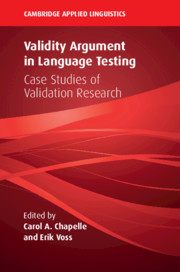Book contents
- Validity Argument in Language Testing
- The Cambridge Applied Linguistics Series
- Validity Argument in Language Testing
- Copyright page
- Contents
- Figures
- Tables
- Contributors
- Series Editor’s Preface
- 1 Introduction to Validity Argument in Language Testing and Assessment
- Part I Basic Concepts and Uses of Validity Argument in Language Testing and Assessment
- Part II Investigating Score Interpretations
- Part III Investigating Score Uses and Consequences
- 10 Justifying the Interpretation and Use of an ESL Writing Final Examination
- 11 An Argument for Use of a Test of Productive Grammatical Ability for Placement into Writing Classes
- 12 Investigating the Consequences of an ESL Placement Test
- Part IV Conclusion
- Index
- References
10 - Justifying the Interpretation and Use of an ESL Writing Final Examination
from Part III - Investigating Score Uses and Consequences
Published online by Cambridge University Press: 14 January 2021
- Validity Argument in Language Testing
- The Cambridge Applied Linguistics Series
- Validity Argument in Language Testing
- Copyright page
- Contents
- Figures
- Tables
- Contributors
- Series Editor’s Preface
- 1 Introduction to Validity Argument in Language Testing and Assessment
- Part I Basic Concepts and Uses of Validity Argument in Language Testing and Assessment
- Part II Investigating Score Interpretations
- Part III Investigating Score Uses and Consequences
- 10 Justifying the Interpretation and Use of an ESL Writing Final Examination
- 11 An Argument for Use of a Test of Productive Grammatical Ability for Placement into Writing Classes
- 12 Investigating the Consequences of an ESL Placement Test
- Part IV Conclusion
- Index
- References
Summary
A web-researching-to-write integrated writing test was developed for the final examination in an ESL academic writing course for international undergraduate students a university in the US. To support the score interpretations, uses of the results for awarding grades, and consequences, research was conducted to investigate the seven inferences that made up the interpretation/use argument: domain definition, evaluation, generalization, explanation, extrapolation, utilization, and consequence implication. To answer research questions motivated by the assumptions in the interpretation/use argument, a convergent mixed methods design was used for data collection and analysis. Data included students’ essay responses, screen recordings, post-test and follow-up test-taker questionnaire responses, post-test and follow-up test-taker interviews, instructor interviews, and documents. Results showed that all of the assumptions underlying the seven inferences in the validity argument were at least partially supported. Further research is suggested to produce additional backing for some inferences. Conclusions are drawn about the usefulness of a validity argument for prompting curriculum change. In addition, this study provides an example of a validity argument constructed for low-stakes classroom-based assessment.
Keywords
- Type
- Chapter
- Information
- Validity Argument in Language TestingCase Studies of Validation Research, pp. 235 - 263Publisher: Cambridge University PressPrint publication year: 2021

